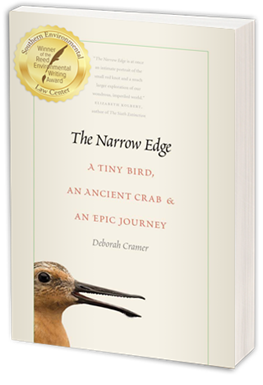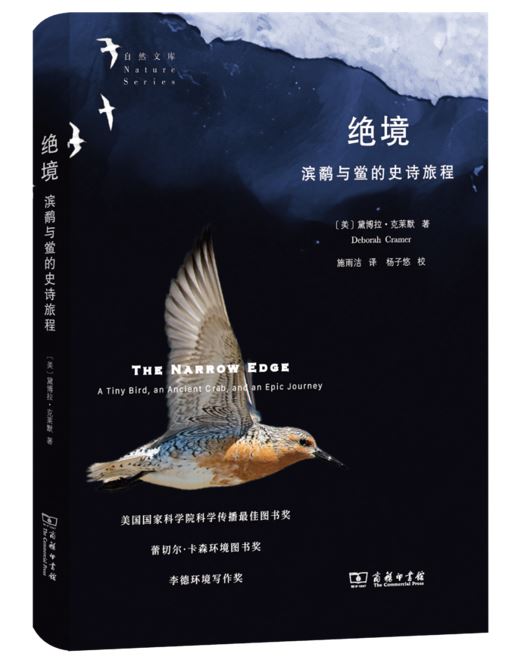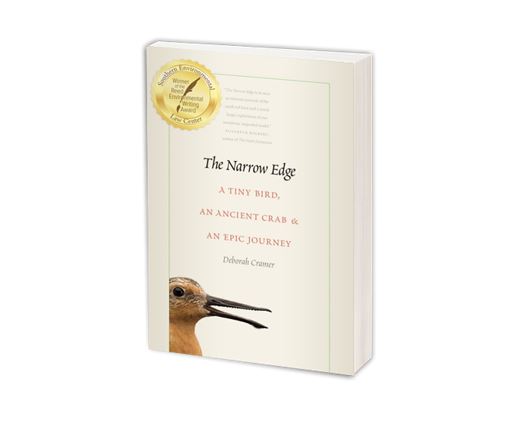
Introduction of the book The Narrow Edge
Each year tiny sandpipers—Red Knots—undertake a near miraculous 19,000 mile journey from one end of the earth to the other and back. In this firsthand account, Deborah Cramer accompanies them on their extraordinary odyssey along the length of two continents, tracking birds from remote Tierra del Fuego to the icy Arctic. On the full moon of spring’s highest tides, she seeks out horseshoe crabs – ancient, primordial animals whose eggs are essential to migrating shorebirds, and whose blue blood, unbeknownst to most people, safeguards human health. The Narrow Edge is a universal story — of migrating shorebirds across the world whose lives are now threatened. It offers unique insight into how the lives of humans, Red Knots and horseshoe crabs are intertwined, and is an inspiring portrait of loss and resilience, of the tenacity of birds, and the courage of the many people who bird by bird and beach by beach, keep red knots flying.
The Narrow Edge received the Best Book Award from the National Academies of Science, the Rachel Carson Book Award from the Society of Environmental Journalists, the Reed Award from the Southern Environmental Law Center, and was designated a “must read” by the Massachusetts Book Award. The Narrow Edge has now been translated into Spanish and Chinese.
“The story of rufa Red Knot in the Americas is similar to the story of Red Knots and many other migratory shorebirds along the East Asian-Australasian Flyway. Many shorebirds in China are also teetering on a narrow edge, because their most important refueling ground – tidal flats along the Yellow Sea-Bohai Gulf – has been encroached with various human activities such as land reclamation and port development. I think the book will encourage people to rethink their relationship with wildlife and nature.” Ziyou Yang, conservationist at Spoon-billed Sandpiper in China.
About the author
Deborah Cramer lives with her family at the edge of a salt marsh in Gloucester, Massachusetts, where each year she awaits the arrival of horseshoe crabs and alewives in tidal creeks, and the passage of migrating sandpipers and herons. She writes about science, nature, and the environment. Deborah is a Visiting Scholar at the Environmental Solutions Initiative at the Massachusetts Institute of Technology.

For more details: https://deborahcramer.com/books/the-narrow-edge-red-knot/
Chinese version:
《绝境 – 滨鹬与鲎的史诗旅程》简 介

红腹滨鹬是一种在海滨生活的候鸟,体重仅有 140 克左右,不过是一只咖啡杯的重量 而已。但为了赶赴一年一度的北极之约,这种小鸟每年的单程迁飞距离竟长达上万公里。 面对如此遥远的征途,红腹滨鹬的能量从何而来?它们如何做到在绵延不断的海岸线
上精准定位至食物最丰富的滩涂?迁飞途中,一种已经在地球上生活了亿万年的远古生 命,为红腹滨鹬提供了强有力的能量支撑。这便是长相奇特的海洋生物——鲎。古老的鲎 与长距离飞行的候鸟之间有着哪些令人称奇的交集?鲎与人类的健康生存又是如何息息相 关的?当科学家对红腹滨鹬的了解日渐增多,才发现它们的生存正面临严峻的挑战。食物 的短缺、海平面的上升、以及人类对沿海地区大张旗鼓的开发建设,都在威胁红腹滨鹬的 延续。
作者黛博拉·克莱默追随红腹滨鹬,完成了一次近乎横跨南北两极的野外考察之旅。 她在书中讲述了红腹滨鹬与鲎鲜为人知的故事,以及世界各地的科学家为了保护这两种生 物、保护我们的家园所做的不懈努力。
“红腹滨鹬rufa亚种在美洲的遭遇,与其rogersi、piersma亚种以及许多其它鸻鹬类水鸟在东亚-澳大利西亚迁飞路线上所经历的故事相似。许多中国的鸻鹬类水鸟同样也正处于“绝境”之中,因为它们最重要的停歇地——黄渤海湾沿岸滩涂,已被围垦和港口开发等各种人类活动逐渐侵蚀。我认为,此书将启发人们重新思考他们与野生动植物以及自然界之间的关系。” — 杨子悠,”勺嘴鹬在中国” 水鸟保护工作者, 《绝境 – 滨鹬与鲎的史诗旅程》译者
作者简介
黛博拉·克莱默(Deborah Cramer)是麻省理工学院的访问学者,以科学、自然和环境 为主题进行写作。她现居马萨诸塞州格洛斯特一个盐沼边缘,每年在那里等待随着潮水而来 的鲎,观看迁徙的滨鹬和苍鹭。

译者简介
施雨洁,打小喜欢动物,热爱有关自然的一切。乐于与野生动物为伍,致力于提高圈养动物的动物福利。
杨子悠,毕业于昆士兰大学保育生物学专业。现就职于“勺嘴鹬在中国”机构,主要从 事中国黄海地区的水鸟保护工作。





